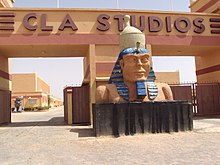Cinema of Morocco
[19] In 2023, Moroccan cinema saw record-breaking production numbers, box office hits, and new infrastructure, partly due to the CCM's support and investments in upgrading and digitizing theaters.[20] Cinema in Morocco has a long history, stretching back over a century to the filming of Le chèvrier Marocain ("The Moroccan Goatherd") by Louis Lumière in 1897.Mostafa Derkaoui's 1973 film About Some Meaningless Events (Arabic: أحداث بلا دلالة) was screened twice in Morocco before it was banned under Hassan II.[29][30] The films Ali Zaoua (2000), Horses of God (2012), Much Loved (2015), and Ghazzia (2017) of Nabil Ayouch—a French director of Moroccan heritage—deal with street crime, terrorism, and social issues in Casablanca, respectively.[35] In his book La septième porte (The Seventh Door), the poet, novelist and filmmaker Ahmed Bouanani (1938-2011) retraces 24 years of Moroccan film history.As described by literary critic and publisher Kenza Sefrioui, who edited Bouanani's personal history of cinema in Morocco, the author "recounts scenarios, he details the atmosphere of the scenes, he attests to reception, and he presents himself as an often ironic, sometimes humorous commentator, in dialogue with his reader.Notable film makers are Hamid Bénani (Wechma, Traces, 1970), Souheil Ben Barka (Les Mille et une Mains, 1974), Moumen Smihi (El Chergui ou le Silence violent, 1975), Ahmed El Maânouni (Alyam, Alyam, 1978; Transes (Al Hal), 1981; Les Cœurs brûlés, 2007), Jilali Ferhati (Poupées de roseau, 1981; La Plage des enfants perdus, 1991), Mustapha Derkaoui (Les Beaux Jours de Shéhérazade, 1982); Farida Benlyazid (Une porte sur le ciel, 1988), Saâd Chraïbi (Chronique d'une vie normale, 1990), Mohamed Abderrahmane Tazi (Badis, 1989; À la recherche du mari de ma femme, 1993), Abdelkader Lagtaâ (Un amour à Casablanca, 1992; La Porte close, 1998), Hakim Noury (Le Marteau et l'Enclume, 1990), Hassan Benjelloun (La Fête des autres, 1990).
screensInternational Film Festivalof MarrakechForeign movies shot in MoroccoArabicMoroccoTamazightLouis Lumièrefeature filmsHamid BénaniWechmacult movieEgyptianmelodramasA Thousand and One HandsFarida BourquiadirectorAl-JamraKing Mohammed VI of MoroccoMarrakech International Film Festivalfantasy filmAchouraAmazighArab cinemaanimated filmsanimated seriesbox officetheatersHollywoodFrenchIndianOuarzazateCinema RialtoCinema Voxregulatory bodySalut Casa!civilizing missionOrson Welles'OthelloPalme d'OrCannes Film FestivalMoroccan national anthemTangierTetouanInternational Film Festival of MarrakechMarrakechMostafa Derkaoui'sAbout Some Meaningless EventsAbdelkrim DerkaouiMuna FettouBouchra Ijork'smade-for-TVBitter OrangeNour-Eddine LakhmariCasanegraAli ZaouaHorses of GodMuch LovedGhazziaNabil AyouchMeryem Benm'Barek-AloïsiHicham LasriSaid NaciriCasablanca BeatsAtlas StudiosWarzazatAhmed BouananiSouheil Ben BarkaMoumen SmihiAhmed El MaânouniJilali FerhatiMustapha DerkaouiFarida BenlyazidAbdelkader LagtaâHakim NouryHassan BenjellounHisham LasriNarjiss NejjarFaouzi BensaïdiLaïla MarrakchiLatefa AhrrareSanâa AlaouiAmal AyouchHassan El FadNadia KoundaMohammed MarouaziSouad AmidouRachid BadouriJamel DebbouzeGad ElmalehSaïd TaghmaouiRoschdy ZemSoufiane El KhalidyEgyptian cinemaList of Moroccan filmsList of foreign movies shot in MoroccoCulture of MoroccoCinema of the worldThe Hollywood ReporterAujourd'hui le MarocHorn of AfricaDjiboutiSomaliaNorth AfricaAlgeriaTunisiaWestern AsiaBahrainJordanLebanonKuwaitPalestineSaudi ArabiaU.A.E.articlesHistoryKingdom of MauretaniaMauretania TingitanaBerber RevoltIdrisid dynastyBarghawata ConfederacyKingdom of Nekor IdrisidsAlmoravidsAlmohadsMarinidsWattasids